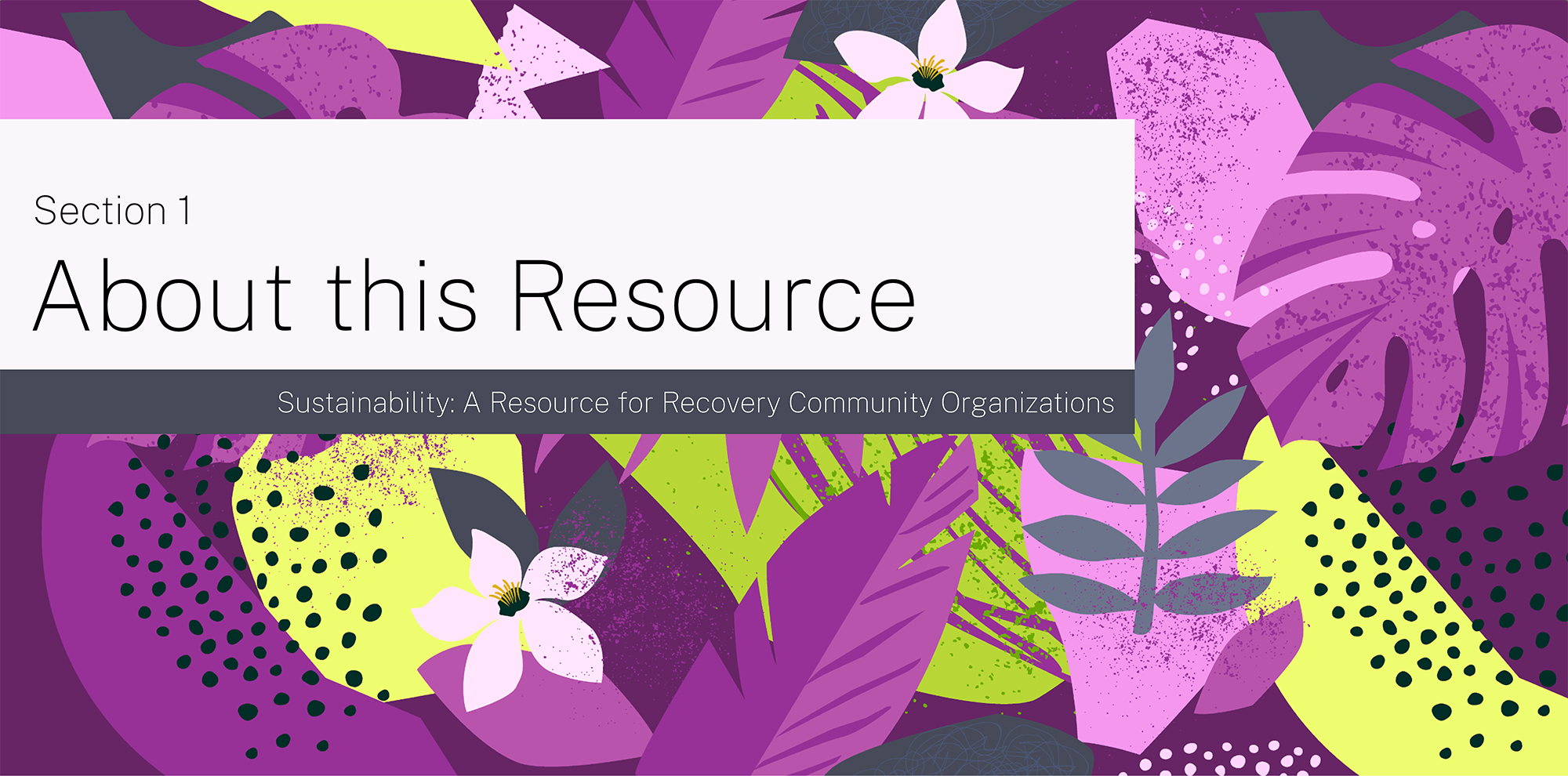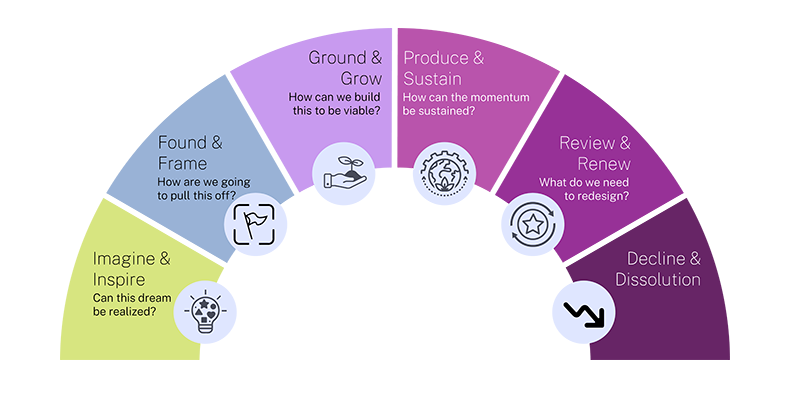
Section 1: About this Resource
The Peer Recovery Center of Excellence (PR CoE) was funded by SAMHSA in 2020 to provide training and technical assistance to the substance use peer recovery field. Since its inception, the Recovery Community Organization (RCO) Capacity Building team has been engaging with RCOs across the nation, hearing their stories of resilience and addressing the sustainability-related challenges they face.
The guide was created for RCOs that have established their nonprofit status and wish to build a strong foundation, grow programs and services, and/or are looking to move to the next phase of development. For individuals or organizations just starting out, we suggest connecting with Faces & Voices of Recovery National Recovery Institute and attending their RCO Bootcamp, or studying the Friends of Recovery - New York Recovery Community Organization Toolkit to better understand the responsibility and commitment needed for founding an RCO.
The pages ahead will explore tools, resources, and insights aimed at strengthening an RCO’s ability to fulfill their mission and achieve their goals. This guide builds upon the invaluable efforts and experiences of others, namely successful Recovery Community Organizations, to increase an organization’s ability to sustain itself. It outlines key areas of consideration and provides information, questions, and ideas that will help RCOs consider how they might have the greatest impact. Each section contains links to opportunities for deeper learning, as well as tools and templates that can be downloaded and put to use right away.
This guide offers not only practical tools and resources, but also encourages self-reflection and critical thinking. We did our best to separate topics into various sections. There is a ton of information contained in this guide. Trying to digest it all at once would be overwhelming. Think of this as a “Choose Your Own Adventure” resource. Each section covers a key area of RCO sustainability. We suggest starting with an assessment of your RCO’s stage in its Nonprofit Lifecycle (which we discuss later in this section). Through this process, you can identify an area of focus, create a plan to implement a few changes, and tackle a new area when you and your team are ready.
At the heart of this resource lies our belief in the profound impact that RCOs have on individuals and communities. In this guide, we aim to provide practical insights on how to effectively strengthen these organizations.
This guide is intended as a starting point, recognizing that the nuances of founding, leading, growing, and sustaining a Recovery Community Organization could fill a whole book or graduate course. Please feel free to adapt these materials to your needs- expand on the topics, revise the content, and share widely with anyone who might find them useful.
RCO Guiding Principles and Practices
Before we dig into the complexities of everything nonprofit, we want to take a moment to highlight the guiding principles that are central to all RCOs. These guiding principles, also known as “National Standards for Recovery Community Organizations,” were developed by Faces & Voices of Recovery and are widely accepted as best practices. These standards are critical to our individual and collective success, and they apply to RCO governance, programs and activities, and Diversity, Equity, Inclusion, Justice, and Belonging (DEIJB). They also influenced how each topic in this guide is described. Take a moment to click on the link above and learn more about these national standards.
As we worked to develop this guide, we paid particular attention to these standards and how the guide topics are described and applied:
- Led and Governed by the Recovery Community
- Grassroots
- Participatory Practice
- All Pathways Towards Recovery
- Diverse, Equitable, and Inclusive Policies, Practices, and Services
- Recovery-Friendly Language
Creating a diverse, equitable, inclusive organization requires continuous learning - reflecting on policies and practices, and making improvements as one learns how to better respond to cultural differences and expectations. Equity is not a standalone topic. We worked to infuse reflective questions and considerations related to equity throughout this guide. Health equity is when everyone, regardless of their race, ethnicity, gender, income, or other social factors, has the opportunity to achieve optimal health and well-being. It’s not just about providing equal access to services and support, but also addressing the structural and social determinants of health that contribute to health disparities. Achieving health equity requires creating policies and systems that remove barriers to good health and promoting community engagement at all stages in the process.
Note
To explore ways to operationalize racial equity within organizations, check out the Racial Equity Toolkit from the Collective Impact Forum. Through a mix of personal reflection exercises, conversations, and activities, this toolkit helps teams explore how centering racial equity can advance their strategies, build understanding, strengthen relationships, and support in reaching their collective goals.
Recovery Community Organization as Nonprofits
Should I start an RCO? Where is our organization in its lifecycle? If we are in one phase and want to move to the next, what about our services or infrastructure do we need to start, stop, strengthen, or change?
Why are RCOs Nonprofit Organizations?
In recent years, there has been a growing recognition of the vital role that RCOs have in helping individuals, families, and communities heal from the impact of addiction. However, there are challenges being raised regarding the necessity for an RCO to be a registered 501(c)(3) nonprofit organization. Let's take a moment to explore the rationale behind this requirement:
- The designation of a 501(c)(3) nonprofit provides a higher level of transparency and public accountability for RCOs, affirming their commitment to the communities they represent and serve. Under the law, a 501(c)(3) nonprofit must be established and operated exclusively for charitable purposes. It cannot be organized or operated to benefit private interests, and its activities should not materially benefit its Board of Directors, leadership, their families, or their business interests.
- Additionally, nonprofit 990 IRS tax returns are public information that require nonprofits to disclose crucial details, such as sources of earned and contributed income, compensation of officers and key personnel, and allocation of functional expenses by program areas. This level of transparency is intended to hold nonprofit organizations accountable for their stated charitable purpose.
- A 501(c)(3) nonprofit has a Board of Directors, typically composed of volunteers, who bear fiduciary responsibility for the organization. By attaining the designation of a 501(c)(3) nonprofit, RCOs are ensuring that, at the very least, they actively engage their local recovery communities through board leadership development and governance.
Should I start an RCO?
It’s important to understand that RCO’s are not just about “doing good”. They are about fulfilling a particular mission, serving a specific community, or addressing a specific issue. They require strategic planning, clear objectives, and measurable outcomes. Running an RCO comes with unique challenges as well; fundraising, volunteer management, compliance with regulations, and public scrutiny. Don’t underestimate these challenges.
If you've considered setting up your own RCO, it's important to take some time to ponder a few important factors before going down this path:
- Is there an existing RCO you can support instead of starting your own? It's worth exploring this option and honestly examining your motivations. Starting and sustaining an RCO requires a commitment that may not be for everyone. There's no shame in supporting another RCO that aligns with what you hope to accomplish.
- Do you have the time and capacity to dedicate to founding an RCO? Building and achieving the goals of starting an RCO takes time, patience, and resilience. If you start with unrealistic expectations of immediate success, you may become discouraged and lose motivation. It's important to approach this journey with a long-term perspective.
- How will you identify the specific community you aim to serve? Take the time to research and engage with the community you intend to support. Understand their unique needs, strengths, and assets. This will help you tailor your services and ensure that you are addressing unmet needs effectively.
- Consider the resources, partnerships, and support you will need to fulfill the unaddressed needs of the community. Reflect on whether you have a solid foundation in place, including the necessary resources, partnerships, and support networks, to meet these needs. Building and sustaining an RCO requires dedicated effort and collaboration.
- What amount of funding will be necessary to initiate and sustain the organization? It's vital to be realistic about the financial implications of starting and running an RCO. Most RCOs rely heavily on donations and grants to ensure their survival. Take into account the continuous effort and dedication required in fundraising. Financial considerations cannot be overlooked.
- Are you equipped to manage the administrative, financial, and legal responsibilities that come with running an RCO? It's essential to have a good understanding of the legal requirements for operating a nonprofit organization, including tax laws, reporting obligations, and regulatory compliance. This ensures that your RCO is operating ethically, and within the boundaries of the law.
- Have you identified potential partners and stakeholders who can support your efforts? Remember, you don't have to go it alone. Seeking out and cultivating partnerships can provide you with specific knowledge, skills, and experience in areas such as legal matters, marketing, and administration. Partnerships can also open doors to new connections and collaborations, strengthening your RCO's impact.
These questions are not meant to discourage anyone from pursuing the development of new RCOs. Instead, they serve as a guide to help navigate the challenges and considerations that come with setting up and running a successful RCO. By carefully considering these factors, you will be better equipped to make informed decisions and contribute to the recovery community in a meaningful and impactful way.
Feasibility Study and Business Plans
If you have already started down the RCO path and want to keep going, there are some tools that can guide you through the planning process, even though they may initially appear overwhelming. These tools are designed to help you navigate and consider all the important variables that contribute to the success of your RCO. Think of them as valuable resources that will assist you in organizing your thoughts, understanding the various aspects of running an RCO, and ultimately creating a strong foundation for your organization.
A feasibility study is a process of investigating and evaluating the potential of a project or idea before diving into it. It helps you determine if something is practical and achievable. In simple terms, it's like doing some homework to find out if your plan is likely to work. It involves researching and analyzing different factors such as the needs of the community, available resources, potential challenges, and the overall possibility of your idea. By doing a feasibility study, you can make informed decisions and have a clearer understanding of whether your project or idea is worth pursuing.
Resource: Check out How to Conduct a Successful Nonprofit Feasibility Study from Donorbox.
A business plan, on the other hand, is like a roadmap or blueprint for starting and running a nonprofit organization. It lays out your goals, strategies, and the steps you need to take to make your nonprofit successful. It includes things like your mission and vision, the programs and services you plan to offer, how you will generate funding, and how you will manage the organization. In other words, a business plan helps you plan and organize all the important details of your nonprofit so that you can stay focused and achieve your goals. It also helps others, such as potential funders and partners, understand your organization's purpose and how you plan to make a positive impact in the community. The Small Business Administration (SBA) shares, “A good business plan guides you through each stage of starting and managing your business. You’ll use your business plan as a roadmap for how to structure, run, and grow your new business. It’s a way to think through the key elements of your business.” The SBA’s page Write your business plan is a good place to start with developing a business plan and helping founders figure out how to do all the extra work to make a business successful. Additionally, Donorbox has a free Nonprofit Business Plan template you can use to start the process.
Writing business plans can help nonprofits clarify their purpose or case, their goals, and their strategies for achieving those goals. They can also help in fundraising or grant writing, as much of the information is often required as a part of grant submissions or fundraising proposals.
Nonprofit Lifecycles

Each RCO is unique unto itself, and the obstacles it navigates will be specific to the context, community, and mission. But, the growth pattern of nonprofits is pretty stable, regardless of its mission, purpose, and geographic location. Below are the stages of a nonprofit’s lifecycle, as described by Judith Sharken Simon in her book, The Five Stages of Nonprofit Organizations followed by examples of what an RCO might be experiencing in that stage:

Imagine & Inspire:
The unmet needs in the community are recognized and a vision or an idea for a solution has been formed. This often looks like an enthusiastic, energized small group of people, meeting some of the needs in informal ways (support groups, educational workshops, public events). Revenue is from in-kind donations and support. Many groups do not move beyond the Imagine & Inspire stage.
During the Imagine & Inspire stage, an RCO would be actively researching and identifying the specific recovery needs within their community. This could involve conducting surveys, conducting listening sessions with community members, and reviewing existing data and research to gain an understanding of the community’s assets and challenges.

Found & Frame:
The energy in a new nonprofit is high, as founders bring their ideas to life. However, the systems supporting these ideas are slower to be developed. The organization is building on the fly, meeting each moment with ideas and passion, and creating a group of supporters who want to be a part of what you are trying to do. The organization has filed its articles of incorporation, has its 501(c)(3) designation, and has a functioning Board of Directors.
During the Found & Frame stage, an RCO may encounter challenges such as establishing a strong mission and vision, securing initial funding, and defining their target population. They might be focused on building partnerships with other community organizations and engaging in advocacy efforts to raise awareness about recovery issues. Additionally, RCOs may be busy creating support programs and services tailored to their community's specific needs.

Ground & Grow:
As the organization gains traction within the community and begins to meet people’s needs, demands rise. These demands stretch the organization’s capabilities and capacities, as its systems are still trying to catch up to all that the organization is doing. It might feel like they are racing the clock to create and produce and show up for the community, sometimes not totally sure which of their efforts will be the most successful.
As an RCO starts to gain momentum, they may experience increased demand for their services and resources. This stage often involves expanding their staff, developing additional programs, and expanding their reach to serve more individuals in need. RCOs in the growth stage may encounter challenges related to managing increased administrative responsibilities, ensuring quality control of services, and maintaining effective communication within their organization and with external stakeholders.

Produce & Sustain:
The organization has been able to bring on a team capable of meeting the demands of the community and build the systems needed to be successful. The organization has found balance in infrastructure and programming - they are no longer stretched beyond capacity while providing our services.
In the Produce & Sustain, an RCO becomes more established and recognized within the community. They may have developed a strong network of partnerships, gained credibility, and established a stable funding base. At this point, the focus might shift towards refining existing programs, engaging in research and evaluation, and positioning themselves as experts in the field of recovery. RCOs in this stage may be involved in policy advocacy, promoting systemic changes, and supporting peer-led initiatives in their community.

Review & Renew:
In Review & Renewal, organizations notice shifts in demand and make adjustments to find a new balance. This can be a stressful time where everything feels “up in the air” and big decisions still need to be made. Established organizations often revisit various aspects of the organization such as mission, vision, services, and structure. It is possible that organizations may need to revert to an earlier stage in the cycle.
Just like any organization, RCOs will face challenges and setbacks, recognizing a need to Review & Renew. This may occur due to factors such as changes in funding, shifts in community needs, or leadership transitions. During this stage, RCOs may need to reassess their strategies, adapt to new circumstances, and seek new opportunities for growth. RCOs might engage in capacity-building efforts, consider collaborations with other organizations, or rebrand themselves to better align with current community needs and priorities.

Decline & Dissolution:
Nonprofits that find themselves in the Decline & Dissolution stage have chosen or been forced to close their doors. This may be a point of celebration, as communities come to no longer need nonprofits focusing on particular issues because they have been solved societally. However, more nonprofits end up in this space as a result of staying too attached to practices or stakeholders that are no longer serving them or looking to them. Organizations must routinely consider their changing economic, political, and cultural landscape and be willing to pivot as access, needs, and issues change.
RCOs nearing the Decline & Dissolution stage might encounter significant obstacles in leadership and governance. These challenges can include a shortage of capable board members, internal conflicts, and ineffective decision-making processes. Such issues can impede the RCO’s effectiveness and hinder its ability to address pressing community needs. Despite this, by documenting its impact and leveraging its history, an RCO in this stage can still play a role in shaping policy recommendations and raising public awareness to foster support for recovery initiatives.
RCOs do not always progress through each stage at the same pace. Some RCOs may spend an extended period in the initial stages, move swiftly through the Produce & Sustain phase, and then find themselves needing to Turn Around. The obstacles they confront and the lessons they learn will be influenced by factors like local resources, community backing, and the policy landscape. Conducting a thorough assessment of your RCO to identify its current stage can assist in strategic planning, determining the need for new programs or staff hires, and evaluating the relevance of existing programs to the community they serve.
Start Here: Nonprofit Lifecycle Assessment Tool
There are a variety of tools an RCO could use to identify where it is in its Nonprofit Lifecycle. We chose a tool from the Social Impact Architects, highlighted in their 2022 article Where is Your Organization in the Nonprofit Lifecycle?. It offers organizations a simple “pen and paper” approach to realizing where they are in their nonprofit lifecycle. You can download and print the Nonprofit Lifecycles Chart from the article.
The article contains instructions for what to do next, which are simplified and adapted for RCOs below:
- Download and print the Nonprofit Lifecycles chart from the article.
- Ask your staff, key volunteers, program participants, and/or community partners to mark where they believe your RCO stands in terms of Impact, Brand, Revenue, Operations & Culture, and Governance. You want a wide variety of perspectives—who is asked is up to you.
- Remind everyone, there are no right or wrong answers, and everyone's perspective is important.
- Identify a staff member who can respond to questions and provide clarifications about the Nonprofit Lifecycles assessment tool.
- Organize a meeting with everyone who completed the exercise to discuss their views. Have an open discussion about how each person sees the RCO in terms of each organizational element, starting with Impact, then Brand, and so on. This discussion is needed because it uncovers what is called a “perception gap,” where people may have different experiences based on their perspective. RCO leadership should share their views last to prevent influencing others.
- After a robust discussion, try to reach consensus on your RCO's current position in each row and decide which column (idea, start-up, growth, maturity, decline, crisis) best represents your current status.
- Use this assessment to identify areas in the RCO that need some love and attention. This information can be used as a starting point to build capacity in a specific part of your organization.

Section 1: Pause & Reflect
At the end of each section, take time to reflect on what was presented, consider how it applies to your unique situations, structures, and goals of your RCO, and identify possible next steps.
- What information or ideas were new, interesting, helpful, or hopeful in this section?
- How does this section guide your organization in adapting, improving, or building upon the RCO Guiding Principles and Practices listed below? For each point, consider "What is going well?" and "What could be better?"
- Led and governed by members of the recovery community
- Grassroots, local, community-based decision-making
- Participatory practices are emphasized, promoting community involvement and collaboration.
- All pathways and recovery journeys are honored and celebrated
- Diverse, equitable, and inclusive policies, practices, and services
- Recovery-oriented language that is strengths-based and person-centered
- What areas of your organization do you think might need some work or review?

CAPRSS Considerations
At the end of some sections in this guide, you will find a segment titled “CAPRSS Considerations”. These segments highlight particular aspects of Council on Accreditation of Peer Recovery Support Services (CAPRSS) standards that relate to the section topic. See the paragraph below for more information on pursuing CAPRSS accreditation.
The Council on Accreditation of Peer Recovery Support Services (CAPRSS) is the only accrediting body in the United States that aims to promote capacity building and the achievement of excellence within organizations offering peer recovery support services. It is designed to take emerging and established peer recovery support services programs and organizations through an accreditation process that has been developed for and by the recovery community through a rigorous participatory process. The accreditation process is designed to help organizations become accreditation-ready and also help burgeoning organizations start out with a solid infrastructure that will ensure fidelity to best practice in peer support. More detailed information may be found at caprss.org.


